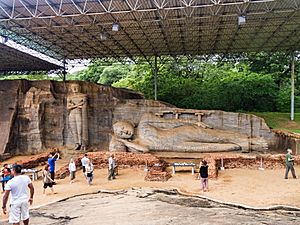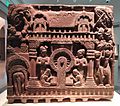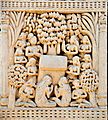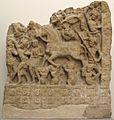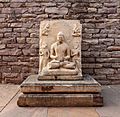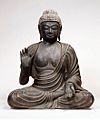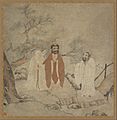Gautama Buddha facts for kids
Gautama Buddha was born in Nepal. His family name is Siddhārtha. Gautama was the person who began the religion of Buddhism. He lived from about 563 BC to about 483 BC. He is also called Sakyamuni or Tathāgat.
Contents
His early years
Siddhārtha Gautama (Sidaaha) was born in the kingdom of Kapilvastu in Nepal. At present this birthplace is called Lumbini, in Nepal. At that time, a clan called the Shakya's ruled Kapilvastu. His father was a king named Suddodana Tharu, and his mother was Maya Devi. Siddhārtha lived in luxury; his father kept trouble and hard work far from him. A seer predicted that if Siddhārth stayed inside his palace his whole life, then he would become a great king. However, if he left the palace, then he would become a great religious leader. The king did not want his son to become a religious leader. He kept Siddhartha in the palace for his whole childhood.
When he was older, his father found a woman for Siddhārtha to marry at the age of 16. He married the woman named Yashodhara, and they had a son, Rahul. Although Gautama had everything he could want, he still was not happy. He wanted to learn the meaning of his existence.
He got out of the castle against his father's orders. He saw the "Four Passing Sights": an old crippled man, a sick man, a dead man, and a holy man with no home. Right then, Gautama knew that nothing can stop people from being born, becoming old, getting sick, and dying. He decided to give up his worldly life. He would not keep his wives, his children, his wealth, or his palace. He would become a holy man with no home. He would look for the answer to the problem of birth, old age, sickness, and death. He left his home in the middle of a dark and stormy night.
Seeking answers
At that time, holy men were usually ascetics. They hurt their bodies in order to help their spiritual beings. They do not do things they like so they can defeat their desires. The most ascetic kinds of holy men were called Jains. They practiced self-denial and made themselves suffer very much. They believed this would free the ātman (soul) from pain and sadness. Siddhārth did these things well. Eventually he was better than his teachers. He still found no answer, and he left his teachers, some friends and he went even farther. He ate only six grains of rice a day. He tried holding his breath. He became just skin and bones, and he nearly died. Still, he had no answer.
Siddhārth started to think again about this path. He thought there might be a better way than hurting himself. He found a fig tree (now called the Bodhi tree) and started to meditate. He told himself that he would not get up until he had found enlightenment. He meditated under the tree for 49 days. His mind is said to have become pure, and then, six years after he began his path, he said he found Enlightenment, and became the Buddha.
The life as a Buddha
When the Buddha became enlightened, he knew the answer to suffering, commonly referred to as dukkha, and he knew how to defeat it. This answer was called the Four Noble Truths. He was not sure if he should teach his new ideas or not. He asked himself if the world was ready for such a deep teaching. However, the god Brahmā Sahampati convinced him, arguing that at least some "with little dust in their eyes" will understand it. The Buddha relented and agreed to teach.
When his sangha, the Buddha's community of Buddhist monks, had grown to around sixty awakened monks, he instructed them to wander on their own, teach and ordain people into the community, for the "welfare and benefit" of the world.
For the remaining 40 or 45 years of his life, the Buddha is said to have travelled in the Gangetic Plain, in what is now Uttar Pradesh, Bihar, and southern Nepal, teaching a diverse range of people: from nobles to servants. When he taught, he did not pretend to be a god. He said he was just a man who had found the meaning of life (enlightenment), and that any person can also find the meaning of life. Many people became enlightened because of him. Although the Buddha's language remains unknown, it is likely that he taught in one or more of a variety of closely related Middle Indo-Aryan dialects, of which Pali may be a standardisation.
At the age of 80, Gautama Buddha died of food poisoning. The Buddha's final words are reported to have been: "All saṅkhāras decay. Strive for the goal with diligence (appamāda)" (Pali: 'vayadhammā saṅkhārā appamādena sampādethā'). He then entered his final meditation and died, reaching what is known as parinirvana (final nirvana, the end of rebirth and suffering achieved after the death of the body).
The Buddha's body was then cremated and the remains, including his bones, were kept as relics and they were distributed among various north Indian kingdoms like Magadha, Shakya and Koliya. These relics were placed in monuments or mounds called stupas, a common funerary practice at the time. Centuries later they would be exhumed and enshrined by Ashoka into many new stupas around the Mauryan realm. Many supernatural legends surround the history of alleged relics as they accompanied the spread of Buddhism and gave legitimacy to rulers.
The life teachings
The teachings of the Buddha are known as Buddhism. Buddhism is mostly about ending the feeling of pain that all people feel inside. Gautama Buddha taught that pain is a part of all life. He taught that pain is because of desire. And he showed that there is a way to end desire and end pain by doing good things, not doing bad things, and training one's mind. This is done to end pain and gain enlightenment.
Buddhism teaches non-harm and balance – not going too far one way or the other. The Buddha taught people to meditate, or think deeply, while sitting in the lotus position. Some Buddhists chant and meditate while walking. Buddhists sometimes do these things to understand the human heart and mind. Sometimes they do these things to understand the way the world works. Sometimes they do these things to find peace.
The Buddha would not say if gods exist or not. He taught that people should not look to gods to save them or bring them enlightenment. The gods may have power over world events and they might help people, or they might not. But Buddha believed that it is up to each person to become enlightened.
Four Noble Truths
The Buddha's first and most important teachings are the Four Noble Truths.
- Life is suffering.
- The reason for this suffering is that we want things to be a certain way.
- The way to cure suffering is to rise above this desire.
- The way to rise above desire is to follow the Noble Eightfold Path, practices which help us change our minds and understanding.
Noble Eightfold Path
The Buddha told people to follow a special way of life called the Noble Eightfold Path if they want to understand the Four Noble Truths. These are:
- Appropriate views. Know and understand the Four Noble Truths.
- Appropriate thought. Turn your mind away from the world and toward the Dharma.
- Appropriate speech. Tell the truth, don't gossip, and don't talk badly about others.
- Appropriate conduct. Don't commit evil acts, like killing, stealing, or living an unclean life.
- Appropriate livelihood. Earn your money in a way that doesn't harm anyone.
- Appropriate effort. Work to make your mind more good and less evil.
- Appropriate mindfulness. Remember the Dharma and apply it all the time.
- Appropriate meditation. Practice meditation as a way of understanding reality.
Five precepts
Buddhists are encouraged to follow five precepts, or guidelines:
- I will not hurt a person or animal that is alive.
- I will not take something if it was not given to me.
- I will not engage in sexual misconduct.
- I will not lie or say things that hurt people.
- I will not take intoxicants causing heedlessness.
If a person wants to be a monk or nun, he or she will follow other precepts as well.
Samsara
According to Buddhism, "suffering" (dukkha) is an inevitable part of the repeated cycle of becoming and rebirth, known as Samsara. Dukkha can be understood as the "unsatisfactoriness" or "unease" that comes when people expect enduring happiness from things which are impermanent. The ultimate noble goal of every man is to attain vimutti (liberation) from this vicious cycle.
Samsara is dictated by karma (an impersonal natural law, similar to how certain seeds produce certain plants and fruits). The Buddha's teaching of karma differed to that of the Jains and Brahmins, in that on his view, karma is primarily mental intention (as opposed to mainly physical action or ritual acts). Richard Gombrich summarizes the Buddha's view of karma as follows: "all thoughts, words, and deeds derive their moral value, positive or negative, from the intention behind them."
Dependent Origination

In the early texts, the process of the arising of dukkha is explicated through the teaching of dependent origination, which says that everything that exists or occurs is dependent on conditioning factors. The most basic formulation of dependent origination is given in the early texts as: 'It being thus, this comes about' (Pali: evam sati idam hoti). This can be taken to mean that certain phenomena only arise when there are other phenomena present, thus their arising is "dependent" on other phenomena.
Anatta
The Buddha saw his analysis of dependent origination as a "Middle Way" between "eternalism" (sassatavada, the idea that some essence exists eternally) and "annihilationism" (ucchedavada, the idea that we go completely out of existence at death). In this view, persons are just a causal series of impermanent psycho-physical elements, which are anatta, without an independent or permanent self. The Buddha instead held that all things in the world of our experience are transient and that there is no unchanging part to a person. According to Richard Gombrich, the Buddha's position is simply that "everything is process".
The path to liberation
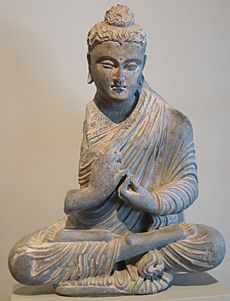
The Buddha taught a path (marga) of training to undo the samyojana, kleshas and āsavas and attain vimutti (liberation). This path taught by the Buddha is depicted in the early texts as a "Middle Way" between self-indulgence on one hand and mortification of the body on the other.
Bhāvanā, cultivation of wholesome states, is central to the Buddha's path. Common practices to this goal, which are shared by most of these early presentations of the path, include sila (ethical training), restraint of the senses (indriyasamvara), sati (mindfulness) and sampajañña (clear awareness), and the practice of dhyana, the cumulative development of wholesome states leading to a "state of perfect equanimity and awareness (upekkhā-sati-parisuddhi)."
Homeless life
The early Buddhist texts depict the Buddha as promoting the life of a homeless and celibate "sramana", or mendicant, as the ideal way of life for the practice of the path. He taught that mendicants or "beggars" (bhikkhus) were supposed to give up all possessions and to own just a begging bowl and three robes. As part of the Buddha's monastic discipline, they were also supposed to rely on the wider lay community for the basic necessities (mainly food, clothing, and lodging).
The Buddha's teachings on monastic discipline were preserved in the various Vinaya collections of the different early schools.
Buddhist monastics, which included both monks and nuns, were supposed to beg for their food, were not allowed to store up food or eat after noon and they were not allowed to use gold, silver or any valuables.
Worldly happiness
The Buddha teaches two types of happiness. First, there is the happiness visible in this very life. The Buddha states that four things lead to this happiness: "The accomplishment of persistent effort, the accomplishment of protection, good friendship, and balanced living." Similarly, in several other suttas, the Buddha teaches on how to improve family relationships, particularly on the importance of filial love and gratitude as well as marital well-being.
Related pages
Images for kids
-
Seated Buddha from Tapa Shotor monastery in Hadda, Afghanistan, 2nd century CE
-
Inscription "The illumination of the Blessed Sakamuni" (Brahmi script: 𑀪𑀕𑀯𑀢𑁄 𑀲𑀓𑀫𑀼𑀦𑀺𑀦𑁄 𑀩𑁄𑀥𑁄, Bhagavato Sakamunino Bodho) on a relief showing the "empty" Illumination Throne of the Buddha in the early Mahabodhi Temple at Bodh Gaya. Bharhut, c. 100 BCE.
-
One of the earliest anthropomorphic representations of the Buddha, here surrounded by Brahma (left) and Śakra (right). Bimaran Casket, mid-1st century CE, British Museum.
-
The "Great Departure" of Siddhartha Gautama, surrounded by a halo, he is accompanied by numerous guards and devata who have come to pay homage; Gandhara, Kushan period
-
Prince Siddhartha shaves his hair and becomes a śramaṇa. Borobudur, 8th century
-
The gilded "Emaciated Buddha statue" in Wat Suthat in Bangkok representing the stage of his asceticism
-
The Mahabodhi Tree at the Sri Mahabodhi Temple in Bodh Gaya
-
The Enlightenment Throne of the Buddha at Bodh Gaya, as recreated by Emperor Ashoka in the 3rd century BCE.
-
The remains of a section of Jetavana Monastery, just outside of ancient Savatthi, in Uttar Pradesh.
-
Ajatashatru worships the Buddha, relief from the Bharhut Stupa at the Indian Museum, Kolkata
-
This East Javanese relief depicts the Buddha in his final days, and Ānanda, his chief attendant.
-
Mahaparinibbana scene, from the Ajanta caves
-
The Bodhisattva meets with Alara Kalama, Borobudur relief.
-
Buddha meets a Brahmin, at the Indian Museum, Kolkata
-
The Buddha on a coin of Kushan ruler Kanishka I, c. 130 CE.
-
Buddha Preaching in Tushita Heaven. Amaravati, Satavahana period, 2d century CE. Indian Museum, Calcutta.
-
Birth of the Buddha, Kushan dynasty, late 2nd to early 3rd century CE.
-
Buddha at Cave No. 6, Ajanta Caves.
-
Chinese Stele with Sakyamuni and Bodhisattvas, Wei period, 536 CE.
-
The Shakyamuni Daibutsu Bronze, c. 609, Nara, Japan.
-
Amaravati style Buddha of Srivijaya period, Palembang, Indonesia, 7th century.
-
Buddha in the exposed stupa of Borobudur mandala, Central Java, Indonesia, c. 825.
-
Vairocana Buddha of Srivijaya style, Southern Thailand, 9th century.
-
Seated Buddha, Japan, Heian period, 9th-10th century.
-
Burmese style Buddha, Shwedagon pagoda, Yangon.
See also
 In Spanish: Buda Gautama para niños
In Spanish: Buda Gautama para niños




